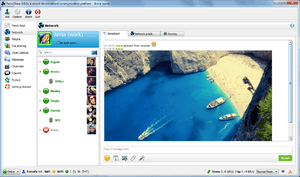RetroShare
 | |
 | |
| Developer(s) | RetroShare Team |
|---|---|
| Initial release | 2006[1] |
| Preview release |
0.6.2
/ 10 March 2017 |
| Repository | https://github.com/RetroShare/RetroShare, https://github.com/RetroShare/RetroShare.git |
| Development status | Active |
| Written in | C++ |
| Operating system | Windows, Linux, OS X, FreeBSD |
| Available in | 38 languages[2] |
|
List of languages English, Arabic, Bulgarian, Catalan (Spain), Chinese (China), Chinese (Taiwan), Czech, Danish, Dutch, Estonian, Finnish, French, Galician, German, Greek, Hebrew, Hungarian, Indonesian, Italian, Japanese, Korean, Macedonian, Malayalam, Norwegian Bokmål, Occitan, Polish, Portuguese, Portuguese (Brazil), Portuguese (Portugal), Romanian, Russian, Serbian, Slovenian, Spanish, Swedish, Turkish, Ukrainian, Vietnamese | |
| Type | Anonymous P2P, friend-to-friend, chat, instant messaging, newsgroups, voice over IP, darknet, social network, email client |
| License | GNU General Public License |
| Website |
retroshare |
| Part of a series on |
| File sharing |
|---|
| Technologies |
| Networks and protocols |
| Development and societal aspects |
| Non-public file sharing |
| Websites and services |
| Clients |
|
|
| Academic/scholarly |
| By country or region |
| Related |
RetroShare is open source software for encrypted filesharing, serverless email, instant messaging, online chat, and BBS, based on a friend-to-friend network built on GNU Privacy Guard (GPG). It is not strictly a darknet since optionally, peers may communicate certificates and IP addresses from and to their friends.[3][4]
History
There has been an unofficial build for the single-board computer Raspberry Pi, named PiShare, since 2012.[5]
The web site 'PRISM Break' has recommended RetroShare for anonymous file sharing since 2013.[6]
On November 4, 2014, RetroShare scored 6 out of 7 points on the Electronic Frontier Foundation's secure messaging scorecard. It lost a point because there has not been a recent independent code audit.[7]
Features
Authentication and connectivity
After initial installation, the user generates a pair of (GPG) cryptographic keys with RetroShare.
After authentication and exchanging an asymmetric key, OpenSSL is used to establish a connection, and for end to end encryption. Friends of friends cannot connect by default, but they can see each other, if the users allow it.
IPv6 support is planned for the RetroShare 0.6 release branch with a possible release in 2016.
File sharing
It is possible to share folders between friends. File transfer is carried on using a multi-hop swarming system (inspired by the "Turtle Hopping" feature from the Turtle F2F project, but implemented differently). In essence, data is only exchanged between friends, although it is possible that the ultimate source and destination of a given transfer are multiple friends apart. A search function performing anonymous multi-hop search is another source of finding files in the network.
Files are represented by their SHA-1 hash value, and HTTP-compliant file and links may be exported, copied, and pasted into/out of RetroShare to publish their virtual location into the RetroShare network.
Communication
The services that RetroShare offers for communication are :
- a private chat
- a private mailing system allow secure communication between known friends and distant friends
- public and private multi-user chat lobbies
- a forum system allowing both anonymous and authenticated forums which distributes posts from friends to friends
- a channel system offers the possibility to auto-download files posted in a given channel to every subscribed peer, similar to RSS feeds
- a Posted links system, where links to important information can be shared
- VoIP calls
- Video calls (since version 0.6.0)
- Tor and I2P networks support, for further anonymisation (since version 0.6.0).
User interface
The core of the RetroShare software is based on an offline library, to which two executables are plugged:
- a command-line interface executable, that offers nearly no control, but it useful to run on a server 'headless'
- a graphical user interface written in Qt 4, which is the one most users use. In addition to functions quite common to other file sharing software, such as a search tab and visualization of transfers, RetroShare gives users the potential to manage their network by collecting optional information about neighbour friends and visualizing it as a trust matrix or as a dynamic network graph. The appearance can be changed by choosing one of several available style sheets.
Anonymity
The friend-to-friend structure of the RetroShare network makes it difficult to intrude and hardly possible to monitor from an external point of view. The degree of anonymity may be improved further by deactivating the DHT and IP/certificate exchange services, making the RetroShare network a real Darknet.
Friends of friends may not connect directly with each other; however, the possibility exists of anonymously sharing files with friends of friends, if enabled by the user. Search, access, and both uploading and downloading of these files is made by "routing" through a series of friends. This means that communications between the source of data (the uploader) and the destination of the data (the downloader) is indirect through mutual friends. Although the intermediary friends cannot determine the original source or ultimate destination, they can see their very next links in the communication chain (their friends). Since the data stream is encrypted, only original source and ultimate destination are able to see what data is transferred.
See also
References
- ↑ "RetroShare aims to be a private F2F social network | SourceForge Community Blog". Sourceforge.net. 2010-05-11. Retrieved 2016-12-04.
- ↑ "RetroShare localization". Transifex.com. Retrieved 2016-12-04.
- ↑ "Anonymous, Decentralized and Uncensored File-Sharing is Booming". TorrentFreak. 2012-03-03. Retrieved 2016-12-04.
- ↑ "Handbook of Peer-to-Peer Networking | Xuemin (Sherman) Shen". Springer. Retrieved 2016-12-04.
- ↑ "PiShare download". SourceForge.net. Retrieved 2016-12-04.
- ↑ Peng Zhong (2003-07-16). "Projects". PRISM Break. Retrieved 2016-12-04.
- ↑ "Secure Messaging Scorecard. Which apps and tools actually keep your messages safe?". Electronic Frontier Foundation. 2014-11-04.